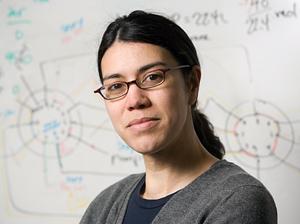June 2010
Chemistry professor Karena McKinney hopes that we will all one day breathe a little easier now that she has gotten the green light to purchase a rare, high-tech piece of machinery for her research on air pollutants.
The extremely sensitive instrument, called a proton transfer reaction time-of-flight mass spectrometer, is one of only a handful worldwide. It will enable her to take real-time measurements of airborne volatile organic compounds (VOCs) in the field. Previously, McKinney and her fellow atmospheric chemists analyzed air samples using far less sophisticated techniques, and often had to bring the samples back to the lab to study.
 |
“Collecting data that way was problematic for a variety of reasons,” said McKinney. “This instrument will allow us to gain a much better and more accurate understanding of what kinds of molecules are in the air we breathe and how they interact with one another. What we find could have implications for emissions regulations and perhaps even air quality legislation.”
The mass spectrometer—which McKinney expects to arrive on campus in November or December—comes courtesy of the National Science Foundation, which recently awarded her a $626,024 American Recovery and Reinvestment Act Major Research Instrumentation Grant to purchase the instrument. The award also subsidizes McKinney’s continued collaboration with co-principal investigator and Harvard University environmental chemist Scot Martin, whose lab features a room that simulates the atmosphere but controls for light, temperature, air composition and other variables.
McKinney and her research team will use the mass spectrometer to do much of their fieldwork in nearby Petersham, Mass. They will then take advantage of Martin’s environmental chamber, as it is called, to reproduce reactions in nature with particular compounds that they have isolated and to examine and analyze those reactions.
“What’s great about this grant is that it will allow me to introduce this instrument and type of exploration to Amherst undergraduate research assistants,” McKinney commented. “My hope is that it will give them a sense of what it means to conduct research at an academic institution at the postgraduate level.”
McKinney has long studied VOCs, carbon-based chemicals that research has shown to be a major contributing factor to the production of ozone (not to be confused with the ozone layer), smog and aerosols. The presence of these gases and particles in the air result in reduced visibility and respiratory problems for individuals, particularly during warmer months, as solar ultraviolet radiation drives the reactions that produce them.
McKinney is interested in the two sources of VOCs—those created by humans and those occurring naturally in plants—and how VOCs are oxidized and interact with other chemicals at ground level. (Man-made VOCs come from fossil fuel combustion, paints, cleaning products and air fresheners, among other things, but these sources are vastly outweighed by natural emissions.)
“Ultimately the goal of the science is to provide information on the chemistry of these compounds so that regulatory agencies—the EPA, for example—can make the most strategic decisions in terms of putting restrictions in place for improving air quality,” she said. “What emissions do you regulate if you want to control smog, for example?”
But a broader knowledge of these reactions will also provide a greater understanding of the role of climate, too, said McKinney: “We hope this research will give us a better handle on the effect of climate change on plants and their emissions,” she explained. “How will that, in turn, affect air quality going forward? There’s a very close link between the environmental conditions in the atmosphere and what the trees are doing.”
“We want to be able to understand that so that we can project—and, who knows, maybe even improve—what the air quality might be like in the future.”